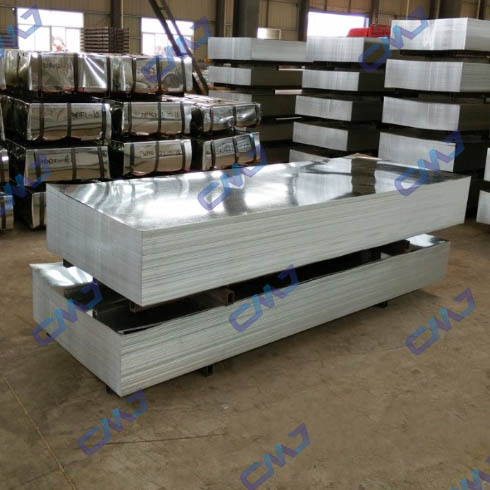A514 Grade Comparison: Grade B, E, H, Q Differences
353Compare A514 steel grades B, E, H, and Q with this detailed guide. Learn yield strength, thickness, toughness and procurement insights for your project.
View detailsSearch the whole station

Galvanized steel is widely used across industries due to its durability, corrosion resistance, and cost-effectiveness. Whether you’re planning infrastructure, roofing, ductwork, or general fabrication, choosing the correct galvanized steel thickness is a key step in ensuring structural performance and longevity.
This guide explains how metal thickness is measured, standard gauges, and how different thicknesses apply to real-world projects.
Galvanized thickness typically refers to the total thickness of a galvanized steel sheet, including the base steel and zinc coating layers on both sides. It affects everything from corrosion protection to structural load-bearing capacity.
Common terms buyers may encounter include:
Together, they determine the galvanized steel sheet thickness, which is critical for performance in different applications.
In the steel industry, gauge is the standard unit used to measure the thickness of steel sheets. Different gauge values represent varying thicknesses. For example, 11 gauge steel has a different thickness compared to 16 gauge steel, making it suitable for different applications. To help you understand these standards better, the following table compares the thickness and size of commonly used galvanized steel sheets.
| Gauge | Steel Thickness (mm) | Steel Thickness (inches) |
|---|---|---|
| 10 | 3.51 | 0.138 |
| 12 | 2.77 | 0.109 |
| 14 | 1.90 | 0.075 |
| 16 | 1.52 | 0.060 |
| 18 | 1.27 | 0.050 |
| 20 | 0.91 | 0.036 |
| 22 | 0.76 | 0.030 |
| 24 | 0.61 | 0.024 |
| 26 | 0.46 | 0.018 |
Note: These are nominal values for hot-dipped galvanized steel sheets. The galvanized sheet metal thickness may vary depending on national standards (ASTM, JIS, EN, etc.).
Zinc coating adds both corrosion resistance and slight dimensional thickness. Typical coatings include:
| Coating Grade | Coating (g/m²) | Approx. Added Thickness (μm) |
|---|---|---|
| Z80 | 80 | ~5.6 |
| Z180 | 180 | ~12.6 |
| Z275 | 275 | ~19.3 |
| Z350 | 350 | ~24.6 |
Higher zinc thickness improves longevity in corrosive environments such as marine or industrial zones.
Selecting the right galvanized thickness depends on:
Looking for pre-cut or custom-sized galvanized plates? View our Galvanized Steel Plate page for a wide range of thickness options.
Different markets use different standards—gauge (US), mm (Europe/Asia), or inches (some industrial standards). This can lead to ordering errors.
For example:
When comparing offers or preparing RFQs, always confirm whether the supplier lists thickness of galvanized steel as actual thickness, nominal, or after-coating thickness.

Choosing the right gauge and thickness of galvanized steel depends largely on the specific requirements of your project. Here’s a quick overview of how the gauge influences the suitability of galvanized steel for various uses:
| Application | Recommended Gauge | Thickness (inches) |
|---|---|---|
| Heavy-duty machinery | 11 or 12 Gauge | 1/8 – 3/32 |
| Automotive body panels | 14 Gauge | 5/64 |
| Furniture manufacturing | 14 or 16 Gauge | 5/64 – 1/16 |
| Roofing panels | 16 or 20 Gauge | 1/16 – 1/32 |
| Electrical enclosures | 16 Gauge | 1/16 |
| Decorative applications | 16 or 20 Gauge | 1/16 – 1/32 |
Visit our selection guide for galvanized steel sheet to explore other important factors such as coating types, corrosion resistance, and applications that may affect your decision.
If your application requires color coating, UV resistance, or aesthetic finishes, consider pre-painted galvanized steel (PPGI) or pre-painted galvalume (PPGL).
These coated steel plates offer additional protection and customization options, commonly used in roofing panels, sandwich panels, and decorative cladding.
Learn more: Coated Steel Plates
Q1: What is the difference between galvanized sheet metal thickness and steel thickness?
Steel thickness refers to the base metal, while galvanized sheet metal thickness includes both the steel core and the zinc layer.
Q2: How thick should galvanized steel be for outdoor use?
For outdoor applications, 1.0 mm or above is recommended, along with a minimum Z275 zinc coating for extended durability.
Q3: Is there a standard way to measure galvanized steel thickness?
Yes. Non-destructive thickness gauges (magnetic or ultrasonic) are used to measure both metal thickness and zinc coating precisely.
Q4: What is the most common galvanized steel thickness for roofing?
A: Typically between 0.45 mm to 1.2 mm, depending on wind load and building code.
Q5: Is the zinc coating included in the listed thickness?
A: That depends. Some manufacturers list thickness before coating; always clarify.
Q6: How thick is 1/8 galvanized steel plate?
A: Approximately 3.2 mm or 0.125 inch.
The right thickness of galvanized steel is crucial for structural performance, cost efficiency, and durability. Whether you’re working with galvanized sheet metal thickness in millimeters or gauges, always request clear specifications and verify coating standards.
For bulk inquiries, customized dimensions, or technical consultation, feel free to request a quote.
Email: info@cjmstainlesssteel.com
WhatsApp: +86 18191906640
Compare A514 steel grades B, E, H, and Q with this detailed guide. Learn yield strength, thickness, toughness and procurement insights for your project.
View detailsLearn the Q195 steel equivalent grades (ASTM, JIS, EN), compare Q195 vs Q235 properties, and how to source Q195 steel plate or coil at wholesale prices.
View detailsUse our steel plate weight calculator to quickly estimate steel weight for carbon, stainless, or galvanized sheets.
View detailsUnderstand the key differences between carbon steel and alloy steel. Compare strength, cost, and best use cases. Expert buying tips from CJM.
View details
HelloPlease log in